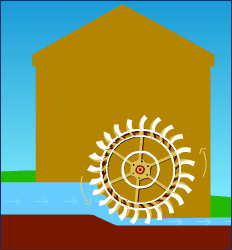The Power of Water

Grain millers were among the first to harness the motive power of water several thousand years ago. Millhouses built along a river or stream featured a waterwheel that was propelled by the water’s current; this wheel then rotated a millstone that crushed grain to make flour.
For water to create a force capable of propelling turbines in a hydroelectric plant, the flow must be strong enough and the head must be high enough. The flow is the volume of water running past a given point for a given time period, usually per second. The head is the difference in elevation between a point upstream of a power plant (the water intake) and a point downstream (the tailrace). The higher the head, the faster the water falls and the more force it exerts on the turbine blades. This explains why certain rivers require retaining structures to raise the head.


